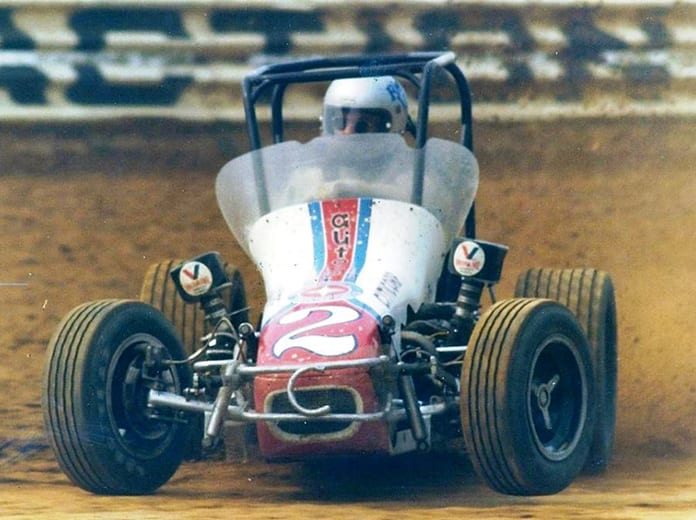
Soon after that, Vogler hooked up with Ray and Cissy Smith, and in 1976 he landed with Sherman Armstrong’s potent team. Vogler continued driving for some of sprint car racing’s best teams, Johnny Vance’s and Gus Hoffman’s among them, eventually winning 34 USAC sprint car features along with USAC national championships in 1980 and ’89.
Meanwhile, Vogler went from, “not doing much” in USAC midgets, to doing extremely well in that division as he rocketed to the top of the series. His name constantly appeared in racing paper win columns, and he rose to popularity on ESPN’s widely viewed “Thursday Night Thunder” series.
But he also racked up enemies as quickly as victories. Never patient, he earned the uncomplimentary moniker of “Mad Dog,” because in his push to the front he’d run around, over or through people.
Vogler admitted that in his pursuit of winning at all costs, he made mistakes.
“Because I don’t go to the race track to run second, I’ve tried so hard to win that I know I’ve screwed up,” he acknowledged. “I ran into people, especially when I was younger. To win sometimes you have to take chances and do things that maybe you shouldn’t, and hope they work out. Sometimes they don’t. I didn’t intentionally try to run into people, but things happened. Now, I believe I’ve learned when to be aggressive and when not.”
In 1985, Vogler achieved a rare feat for that time period, becoming an active sprint car driver who raced in the Indianapolis 500. He made the Indystarting field five consecutive years, often with only a handful of practice laps in an unfamiliar car before a team pushed him out to qualify.
Competing in the Indy 500 was a personal goal.
“Ever since I started racing, I’ve dreamed about running Indy,” Vogler said. “I had three goals. To make the race. I did that. When I did, I felt if I never made another one, I’ve run the Indy 500. Only a few drivers in the world can say that, especially sprint car drivers. I wanted to finish in the top 10, I did that. (eighth in 1989.) My third goal was to win. I know I have the ability, but it’s getting tougher all the time to do Indy only and be successful.”
For a time, Vogler focused his efforts toward an Indy car career, often passing on sure paydays in midgets or sprint cars to run Formula Super Vees. He attempted to gain experience in rear-engine cars and develop his road racing skills.
Yet, in the end, he realized, “… Indy car racing is a dead-end street for me.”
As a result, he turned to NASCAR.
“Anybody should get to the top of any pile they’re trying to climb,” theorized Vogler about his change in career direction. “And for an oval-track driver that seems to be NASCAR right now.”
He worked to put together a NASCAR program to compete for rookie of the year in 1991, intending to step away from open-wheel racing.
“Maybe I’ll be like Ken Schrader,” laughed Vogler, “and make an appearance in a midget or a dirt car three or four times a year. But I’ll need to focus completely on stock cars.
“And maybe,” he added with what proved to be an ironic twist, “I’ll like all that sheet metal around me. It’s a lot safer.”
As a first step toward that goal, Vogler qualified for the July 22, 1990, NASCAR Cup Series race at Pennsylvania’s Pocono Raceway. He then flew his private plane to Salem (Ind.) Speedway for a USAC sprint car race the night before his Cup Series debut.
He’d suffered through a difficult season to that point, winning only one sprint car race. But Vogler dominated the Joe James/Pat O’Connor Memorial, which was televised by ESPN.
Attempting to lap Wayne Hammond on the penultimate lap, the cars touched and Vogler flipped violently. The impact ripped his helmet from his head and just days before his 40th birthday, Vogler was dead.
Vogler wasn’t big on legacies. However, there were things he wanted fans to know about him.
“I’m intense,” Vogler noted four days before his death as he sat relaxed at his kitchen table. “And I know many times at the track I’ve made people think I’m stuck up, or mad, or don’t want to talk to them. It’s not that. I’m usually concentrating on the car so much; someone can speak, and I just don’t hear them. I might be looking right at you and not really see you. I might even say, ‘Hi,’ and not remember it.
“I know that same intensity on the track has kept me from making as many fans as I could have,” Vogler continued. “I know I’ve made some mad. I’ve made mistakes in trying hard to win. I try not to be that way anymore. At the same time, if I’m running against (Jack) Hewitt or (Steve) Butler, or a guy like that, I’m not going to back down either. I’m going to run them hard. I would like people to know that and respect me for that.”
Up until the time of his death, Richard Frank Vogler ran hard and never backed down.
